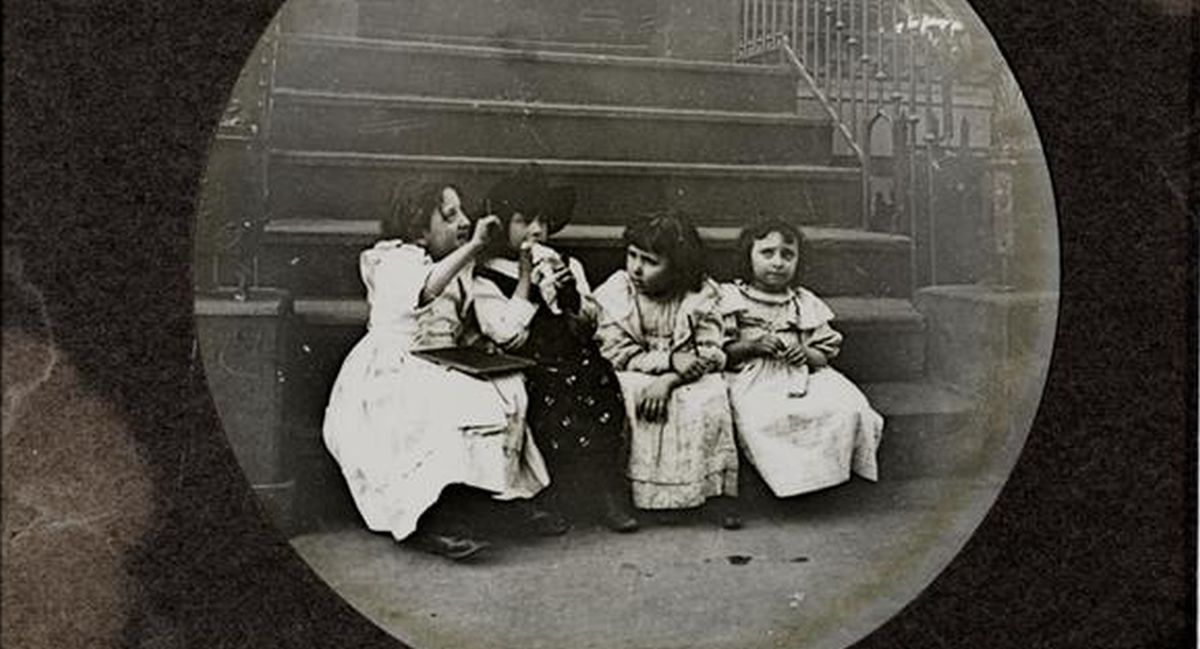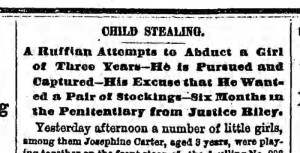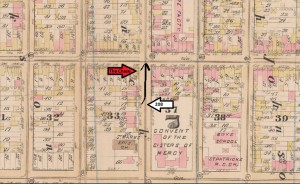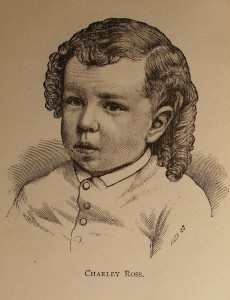A CHILD SNATCHING ON CLASSON (1875)

Brownstone Detectives investigates the history of our clients’ homes.
The story you are about to read was composed from research conducted in the course of one of those investigations.
Do you know the history of YOUR house?
********************************************************************************************************************************
He was “large.” He was “repulsive looking.” And he wanted to steal a child.
And so, when Michael Kelly, of No. 22 Franklin Avenue, heard the joyous amusements of a number of young children upon a stoop at No. 208 Classon Avenue, he was resigned that he should have one.

Ascending to where they were, he seized little Josephine Carter, aged 3 years, and “despite her cries of alarm, began a hasty retreat.”
As he reached the bottom step and turned to flee down the walkway, little Josephine’s head knocked violently against the iron railing, causing her to cry all the more loudly.
The children who remained on the stoop, “their playmate having been removed so from their midst, were all terrified, and began to cry in concert.” This crying attracted the attention of a Mrs. Hartley, who resided next door at No. 206 Classon. She, “supposing there had been an accident of some sort, hastened to the street just in time to see Kelly running off with the little girl.”
THE CHASE
“Very pluckily she followed him for nearly half a block and finally overtook him. Demanding the instant release of the child, she wanted to know why he was carrying it away.” Kelly, though, pretended to be deaf and dumb. He threw the baby down and attempted to escape.
A crowd had collected by this time and Hartley asked a young boy to seek the police. Policeman Olsen, of the Fourth Precinct, was near at hand. Hearing of the occurrence, he came to the scene and arrested Kelly.

The little girl’s mother made a charge against him, and he was licked up until the next morning.
THE COURT
“I’ll tell the whole truth your Honor. I have been hard up,” announced Kelly. “I wanted a pair of stockings, that’s the plain truth. I didn’t intend to steal the girl and the reason why I didn’t speak to the lady was because I had the fever and ague, and was frightened at the crowd.”
A peddler by trade (the New-York Daily Tribune called him a “tramp), Kelly stated that he had a wife and three children and that he had been arrested several times for intoxication and vagrancy, and locked up.
The fact that the Panic of 1873 was still raging more or less gave credence to the part of his story about his being “hard up,” as many were out of work at the time.
The Justice thought the fellow’s story was rather thin, and so committed him to the County Penitentiary for six months.
WAXING INDIGNANT

The year before, 1874, presented to the United States its first kidnapping for ransom (to receive wide attention by the media). Charley Ross, a 4-year-old boy son of well-to-do parents who was also playing in front of his home in Philadelphia was abducted by two men who lured him away with candy and fireworks. Although, ransom notes began to appear, the child never surfaced and was never heard from again. In December of 1874, a botched burglary attempt in Bay Ridge, Brooklyn, brought about a supposed confession by one of the burglars that they were the abductors of Ross.
The story became a national sensation and placed everyone on the alert about the boogie men that existed everywhere who wanted to steal children and kill them.
When the story of Josephine Carter was published the next year, the wounds of the year before were still fresh in the American psyche. The story brought about renewed indignant statements from the press, decrying the current state of human development.
The Brooklyn Daily Eagle in its “op-ed” section discussed the case at length, surmising that as the girl was very neatly dressed and that the man was hard up, it was likely that Kelly wanted something material other than an actual child – either the child’s stockings for one of his children or the money he could get from selling them. The paper noted that he certainly was not an expert child stealer, as he “would have gone to work in a manner somewhat different.”
But the Eagle was not satisfied with their deliberations on Kelly’s intent, and waxing indignant on the incident, declared its lack of confidence in the progress of humankind.
“Incidents of this nature,” the Eagle opined, “show how far we are from the millennium, and how little there is in the talk of the enthusiasts who from the various pulpits and platforms assail our ears with speeches about the inborn nobility of the human heart and the readiness with which that nobility springs forth at the invitation of kindness.
“For the present,” continued the paper, “not love but a cat-o’-nine-tails is in order.”
———————————————————————————————————————–
 Brownstone Detectives is an historic property research agency. Our mission is to document and save the histories of our clients’ homes. From our research, we produce our celebrated House History Books and House History Reports. Contact us today to begin discovering the history of your home.
Brownstone Detectives is an historic property research agency. Our mission is to document and save the histories of our clients’ homes. From our research, we produce our celebrated House History Books and House History Reports. Contact us today to begin discovering the history of your home.